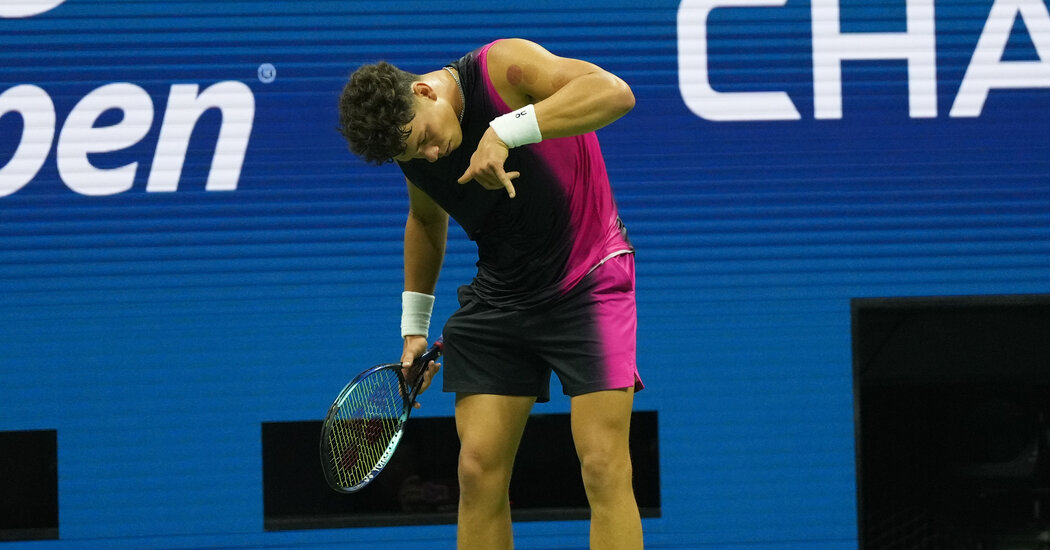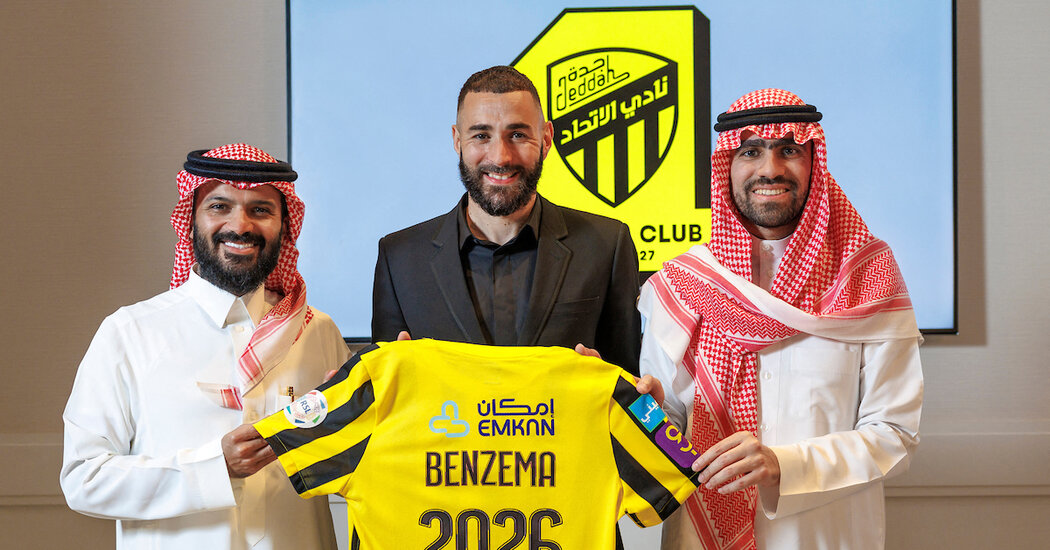This Year’s U.S. Open Belongs to Coco Gauff, Win or Lose
It’s Sunday evening, a little after 6 o’clock, and Coco Gauff is going through her postmatch routine in the section of the Billie Jean King National Tennis Center where players warm up before matches and cool down after them.
Two other stars of American tennis, Frances Tiafoe and Ben Shelton, who are among her close friends, are there, too. Tiafoe is winding down after his fourth-round U.S. Open win, which set up his all-American quarterfinals match against Shelton, who is getting ready to play a mixed doubles match. The friendly trash talk has begun, and Gauff cannot resist being involved. She knows just how to do it.
Tiafoe, who spends a lot of time shirtless and does not lack for confidence when it comes to his rippling physique, and Shelton are playing this tournament in bright sleeveless shirts. Shelton looks better in his, Gauff tells Tiafoe.
And, by the way, so does Carlos Alcaraz, the world No. 1, who beat Tiafoe in the Open semifinals last year and who is also playing in sleeveless Technicolor. “You’re wearing confetti,” Gauff says.
Then she is off to boast that she has gotten the better of one of the princes of the tournament and to make fun of her 60-something coach’s penchant for Jolly Ranchers and the dad-rock tunes he keeps sending her. She must also pose for the endless series of selfies that so many, especially Gen-Z fans, desperately want as they pay her their ultimate compliment.
“My queen,” they say of her.
In the quarterfinals on Tuesday, the sixth-seeded Gauff will face 20th-seeded Jelena Ostapenko of Latvia, who eliminated top-seeded Iga Swiatek in her previous match. If Gauff wins, she will still have to find her way through two more pressure-packed matches to win the tournament. But over a week into the year’s final Grand Slam event, one thing has become clear: Gauff, at age 19, is the queen of this U.S. Open.
Fans hurry across the grounds to get to their seats in Arthur Ashe Stadium before her singles matches. No one wants to miss her first fist-pumping “Come on!” or one of her ball-chasing points that go corner to corner, backcourt to net and then back again, and increasingly end with her cracking an overhead smash or with her opponent sending the ball into the net.
The first-come-first-served seats on the smaller courts with general admission access begin to fill long before she and her doubles partner, Jessica Pegula, take the court. Organizers moved their doubles match on Monday into Ashe when space freed up in the late afternoon. They won.
The N.B.A. player Jimmy Butler of the Miami Heat is one of the many boldface names who have come out for her matches. Others include the singer Justin Bieber and his wife, Hailey, a model and influencer. They were in the house on Friday for Gauff’s third-round win over Elise Mertens. Butler was there, too, and returned for her fourth-round win over Caroline Wozniacki on Sunday.
Gauff’s reaction: “Again?”
Perhaps this was the way it was always going to go for Gauff, who at age 10 earned a coveted spot in the training program at the tennis academy of Patrick Mouratoglou, who coached Serena Williams.
Like anyone who saw Gauff on the court then, Mouratoglou came away impressed with her early speed, power and ability to change direction in an instant and make a quality shot. He called her into his office for an interview, something he puts all of his prospects through, and asked her why she thought she could become a top-level player. She had appeared shy on the court, but now she looked him in the eye from the beginning of their conversation to the end, and told him she wanted this more than any other girl.
A lot of players say that, Mouratoglou said in an interview on Monday. He started putting her on the court in matches against players who were more advanced in their development than she was. More often than not, she found a way to win.
At 13, she made the final of the U.S. Open junior tournament. At 15, she beat Venus Williams on Centre Court at Wimbledon and made the fourth round.
“She is ready for greatness,” Mouratoglou said. “Of course, she feels the pressure like everybody does, but the difference comes from having the belief that you belong there, that you are supposed to do well, that you may be in the spotlight but you enjoy having that pressure, pressure that she has had since she was a kid.”
Living under that scrutiny, especially when early success arrives, can have its advantages and drawbacks. Women’s tennis during the past decade is replete with players who won a Grand Slam event in their late teens or early 20s, then struggled for the next year to win three matches in a tournament.
During her first seasons on the tour, Gauff was impatient to reach the top, given her breakthrough at Wimbledon in 2019 and her run to the French Open final last year. Before this season, though, she spent some time studying the top 10 players and the recent Grand Slam tournament winners. She saw that many of them were peaking from age 22 to 26.
She wasn’t yet 19, but she was about to begin her fifth season of top-level tennis. Her mother told her to be patient, that she didn’t have her “grown woman strength yet,” and said she would know when she got it.
“I guess I’m not as mature as other players are,” she said one afternoon in Australia. “That’s going to come with life on earth, not how many years you are on tour.”
Some may disagree with that assessment. Three years ago, when she was 16, Gauff took the microphone at a Black Lives Matter rally in her hometown, Delray Beach, Fla., days after the murder of George Floyd.
“No matter how big or small your platform is, you need to use your voice,” she told the crowd that day. “I saw a Dr. King quote that said, ‘The silence of the good people is worse than the brutality of the bad people.’ We need to not be silent.”
This summer, she was one of the featured players at the Citi Open in Washington D.C. She had endured some disappointing results in the previous two months, losing to Swiatek for the seventh consecutive time at the French Open in the quarterfinals and bowing out in the first round of Wimbledon.
But the role of a headliner at a midsize tournament comes with some responsibilities. Mark Ein, the owner of the Citi Open, watched as Gauff chatted with V.I.P.s, including a member of President Biden’s cabinet and a justice on the Supreme Court, as if it were business as usual. Then she went out and won the tournament, and Ein sensed there was something different about the teenager who had first played in his event in 2019.
“She gave off this sense of being in control of the situation, both on the court and off,” Ein said. “Every once in a generation in tennis it seems there is someone who breaks through at a very early age, and the test is how you can handle it. The all-time greats seem to have a composure that lets them succeed.”
Since 2019, Gauff’s face has never been hard to find on billboards at any tournament where she is playing. Still, her management team at Team8, the boutique agency that Roger Federer began with his longtime agent, Tony Godsick, has tried to take a slow and steady approach.
She could have deals with dozens of companies. So far, her portfolio beyond the usual racket and clothing sponsors, New Balance and Head, includes only Rolex, Bose, Barilla, Baker Tilly and U.P.S.
Gauff still sometimes rocks back and forth when she is speaking in public. She will giggle at herself in the middle of a sentence. She is still over a year away from ordering a drink legally in the United States.
If she loses to Ostapenko on Tuesday or to someone else in the days ahead, time will still be on her side for a long while. But in many ways, her time has arrived.


